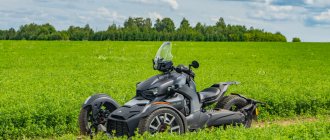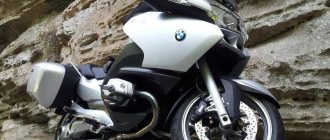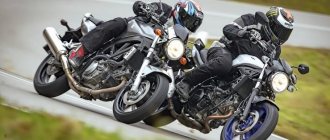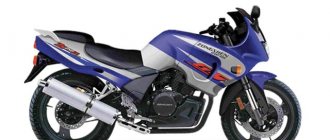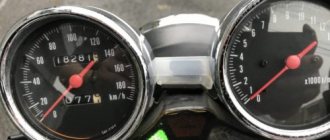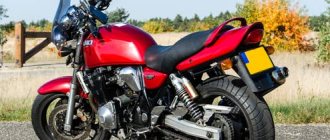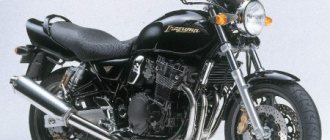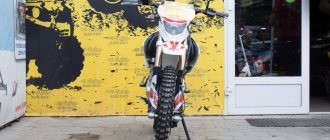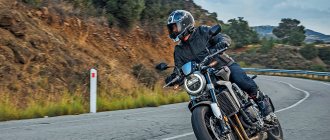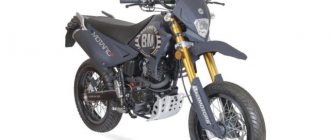A lot of men spend the active part of their lives in a tolerant half-asleep among snotty children, a screaming “zombie box” and a carcass wife who sews her underpants according to army parachute patterns. Or at work, selling electric chisels with a “special attachment” from a sex shop to representatives of “creative” minorities who have dropped out of social life and those with prostatitis. But in the souls of those who have not yet doused the fire of testosterone with beer, a second “I” may awaken.
Can-Am Spyder: “mutant” trike
The Can-Am Spyder tricycle from BRP* does not fit into any boundaries. Fifty kilometers had already flown in the saddle of this monster, but it was impossible to find a definition for the strange monster. Before the start of the test, everything seemed simple: you need to report on the next mutant trike, designed for men in a state of Mariana menopause. The imagination mercilessly pictured a fat-swollen male with symptoms of the “mirror” disease**, turning pale at the thought of riding on two wheels and therefore compensating for the dramatic decrease in male attractiveness with a compromise purchase of a three-wheeled roadster. In reality, everything turned out to be wrong.
The Can-Am Spyder handles like a car and an ATV, i.e. directly
"Spider"*** breaks almost all the foundations developed over years of piloting two-wheeled motorcycles. Having approached the first intersection, I put both feet on the asphalt. And then with a smile he lifted them back onto the steps, unaccustomed to catching the left spoiler. A few minutes later, another “harmless” reflex called “counter-steering” almost caused the Tarantula to fly into the oncoming lane. Thus came the realization of the obvious: the tricycle handles like a car or a quad, and it’s better to keep muscle memory under close control.
“Tarantula” froze in anticipation of the victim
The next discovery came from potholes in the road. Passing them between the front wheels is a task punishable by a sensitive “educational” kick in the ass: “bulges” in the asphalt must be avoided or overcome at extremely low speeds. The same applies to convexities, since the ground clearance of the device with a fairly long base is modest - only 115 mm.
“R” means reverse or reverse
Braking in front of uneven asphalt was also fraught with a surprise. Several times, my right hand automatically fumbled in search of the non-existent front brake lever. The Tarantula has one brake drive - a combined one, and is controlled by a pedal. By the way, it works very well; the anti-blocking system intervenes in the process exactly when needed, and exactly as much as required. However, the brakes won’t allow you to show off, and you won’t be able to lift the vehicle into a stopper—their “combined” nature and the electronic EBD**** system won’t allow it. It is programmed to automatically distribute braking force to achieve maximum deceleration without loss of control. In practice, this means that when the rear wheel locks, EBD will weaken the braking force of the front wheels and kill the thrill in the bud.
Can-Am Spyder is equipped with a rear wheel parking brake
In addition to the main braking system, the Spyder is equipped with a parking brake, operated by a pedal next to the left footrest. The force of the “scissor” is transmitted to the brake caliper of the rear wheel by a cable, so the “parking brake” can theoretically be used as a spare brake system in the event of an incredible failure of the main one.
When accelerating aggressively, the Can-Am Spyder glides over uneven asphalt
The engine of the “spider” caused an attack of pigish delight. Ample low-end torque, ideal linear characteristics, rich exhaust sound from a tuning direct-flow muffler - all this provokes hooligan behavior and turns every start from a traffic light into a race to accelerate to the accompaniment of the squealing of the rear tire. The character of the 998 cc V-twin is surprisingly reminiscent of a “single-barrel” of the same impressive volume. The power is easily enough to accelerate the “tarantula” to 180 km/h, and the acceleration dynamics remain quite energetic up to speeds of 150-160 km/h. Quite - because the amount of acceleration developed by the “spider” is somewhere in the middle between motorcycles of comparable power and family cars, and it will not be able to pull your arms out of your shoulder joints.
Can-Am Spyder handles more like a quad
While driving, new features of the tricycle appeared. Even on a straight, flat road, the device yaws a little, giving the feeling that you are driving a quad (which it almost is). But if you don’t grab the steering wheel with a death grip, then this effect almost disappears, but not completely. But during vigorous acceleration, the Spyder stops transmitting shocks from road irregularities and yaw to the steering wheel, acquires stability, seems to glide over the asphalt, and with all its behavior shows that it likes such “movement.”
It is better to overcome overloads in turns by hanging down
When crossing wide uneven surfaces (for example, a motorcyclist's recumbent friends) not at a right angle, you need to be prepared for a small wobble, which almost instantly disappears, but manages to steer the vehicle a little for the pilot. In smooth, long turns, unlike a motorcycle, the “spider” requires constant pressure on the steering wheel. If the arc is many kilometers long, but if you are not used to it, you can get a little tired, since the DPS***** system is not able to completely relieve your hands. Sharper and slower turns will require active "muscular" steering, and the centrifugal force is felt throughout the body. Therefore, before entering a turn, it is better to move your saddle inside the turn. With such a landing, the hands are less loaded, and the device behaves calmly and predictably.
Stability control prevents the Can-Am Spyder from slipping
In a separate paragraph I will tell you about the operation of the VSS****** system. It is designed to make it easier to control the direction of movement of the device and in fact consists of three independent subsystems: the ABS anti-lock braking system (its operation was mentioned earlier), the TCS traction control system and the SCS stability control system. TCS is designed to prevent rear wheel slip when the steering wheel is turned or at speeds exceeding 50 km/h. SCS monitors the stability of the vehicle by limiting power to the rear wheel and, if necessary, braking one wheel or another to prevent skidding.
Can-Am Spyder "brains" will reduce power when turning the steering wheel and starting to slip
To evaluate the operation of the TCS and SCS systems, I had to drive a little on a gravel road. “Tarantula” behaved in strict accordance with the described algorithm: when turning the steering wheel and reaching approximately 50 km/h, it regularly reduced power, preventing the pilot from having fun with all his guts. At the same time, a feeling of “bummer” arose, similar to what appears when the maximum speed limiter on a motorcycle is activated and the “dynamo” mode is turned on for girls. In short, “Spyder”, like a touchy-feely FIFA, slapped hands every time it “found” even remotely unconventional behavior in the pilot.
Due to the lack of lean in turns, the Can-Am Spyder pilot is subject to noticeable g-forces
After mocking the “spider”, it’s time to relax a little and try to appreciate its qualities in a “peaceful” environment. And suddenly everything fell into place. If you don’t squeeze every last drop of soul out of the Spyder and drive more or less calmly, then the device brings great pleasure from handling “not like everyone else”, appearance “not like everyone else”, generates emotions “not like everyone else” and allows you to look at yourself from a new perspective.
Riding a Can-Am Spyder is like riding on the back of a monster.
The first thing that captivates is appearance. With a pilot in the saddle, the monster resembles a centaur. Only instead of the body of a horse there is the body of a spider. The saddle of the device is very soft, wide and comfortable - 100 kilometers flew without inconvenience in the “South Pole” region. On any asphalt, at least a little less than ideal, the mirrors vibrate a little, but it’s not difficult to see the situation behind. The large multifunctional instrument panel displays a wealth of information without overloading the pilot with it. In an attempt to please the owner, the speed is displayed in the digital form familiar to a sport biker and duplicated on a dial speedometer with a classic appearance. The LCD indicator of the engaged gear in neutral reinforces its readings with a green “N” light on the speedometer dial. And by turning on, for example, the third, you can safely brag to girls and “dummies” about the magnitude of the g-force achieved. Few people will guess that the “3G” symbols on the dashboard carry information about the number of the gear involved.
The Can-Am Spyder instrumentation will provide the pilot with all the necessary information
The Spyder has indicators for fuel level in the tank, coolant temperature, clock and thermometer. Hidden above the instrument cluster is a reminder on the safety of operating the device - in case of abnormal sclerosis or natural tediousness. The clock mode is switched by the “MODE” button on the left remote control. In this case, you can choose between time displays, an odometer for total mileage, two intermediate mileage counters, a chronometer for travel time and engine hours. By the way, with the same button you need to confirm that you have read the instructions after turning on the ignition. A message on the dashboard will insist that you do this immediately after turning the key in the lock. If the button is not pressed, the engine will not start.
“R” means reverse or reverse
An interesting point in controlling the “tarantula” is the algorithm for engaging reverse gear. You need to start the device, click on the “MODE” button (remember, the safety instructions?), turn on the first one and, without releasing the clutch, pull the reverse gear lever on the left handlebar. Then turn on the “first” one again, or rather the back one. Turning off reverse is simpler - depress the clutch and pull the gearshift lever up once to select first (in this case, the “R” lever on the steering wheel will automatically return to its original state), and up again for neutral gear.
The spacious trunk stores comprehensive instruction manuals
A pleasant convenience of the “Spyder” design is an impressive volume (44 liters!) trunk located in the bow of the tricycle. Lonely hidden in it is a standard set of tools, factory instructions and a threatening sticker requiring you not to load more than 16 kilograms into the container. Access to the trunk, as well as to the underseat space, where a couple of sheets of tissue paper can fit, is achieved using the ignition key. We insert it into the lock, press deeper and turn it counterclockwise to open the trunk, or clockwise to raise the seat and access the gas tank neck, the dual reservoir with brake fluid and battery, as well as one of the fuse boxes. The second block can be found “under the hood” to the right of the luggage compartment; to the left of it, under the decorative plastic panel, there is an antifreeze tank and a diagnostic connector.
The rear wheel of a Can-Am Spyder is driven by a timing belt.
If you evaluate the “spider” from a practical point of view, it is easy to fall into error. A comfortable saddle with a backrest for the passenger, an upright seat, a large trunk, ease of control and a bunch of electronics designed to increase safety - the properties of a good “tourist”. However, here too he breaks traditions. Long trips on this device are not excluded. It’s just that in long-distance conditions it will turn out to be much less practical than the average two-wheeled “tourist”. The Spyder's fuel consumption is quite impressive; during the test it averaged 12-13 liters per hundred on the highway, but, admittedly, it was a bit of a show off. Traveling on bad roads, and especially on dirt roads, is sincerely not recommended. The “spider” endures traffic jams on par with cars, which makes it a controversial choice for residents of congested cities. So why buy this quad-triko-bike-mutant?..
The rear of the Can-Am Spyder looks like an insect
But at least for the sake of the primitive thrill of ownership. Have you ever had sex with three girls instead of two? The essence of the three-wheeled Spyder is the same. Extreme ascetics can repeat as much as they like that two are too many. But you and I know how damn nice it is to sometimes treat yourself to innocent excesses.
Anton Barsukov, photo by Viktor Akilov and the author.
The author thanks Alexander “Student” Karnaukhov, Mineralnye Vody, for providing the “Spyder” for testing.
Owner's opinion.
The device attracts attention like “Dom-2” attracts attention from failed porn stars. It’s enough to step away for 5 minutes before a spontaneous photo shoot breaks out around him. And a week later, my wife suddenly begins to be curiously interested in the name of that long-legged girl in the photo on the Internet, and what “bolt” she is sitting on my “tarantula”. A sincere answer “I don’t know” helps for now, but I’m afraid it will end sooner or later. Apart from the excessive attention from random passersby and my beloved wife, the Spyder has become an excellent summer alternative to a car with the added bonus of being “motorcycle-like.”
* Bombardier Recreational Products. ** A design feature in which the “fuel tank” prevents direct visual inspection of the “bolt”, which requires the use of a mirror. *** Spyder – almost like spider – translated as spider. **** Electronic Brake Distribution – electronic brake force distribution system. ***** Dynamic Power Steering – dynamic power steering system. ****** Vehicle Stability System – vehicle stabilization system.
Can-Am Spyder: “Spider” – transformable Front suspension – with two “A”-shaped arms The front of the Can-Am Spyder resembles a predatory spider
Technical specifications
Total information
Model Can-Am Spyder GS Model year 2008 Dry weight, kg 316 Dimensions, mm 2667x1506x1145 Wheelbase, mm 1727 Seat height, mm 737 Gas tank volume, l 25
Engine
Type 2-cylinder, V-shaped, 4-stroke, dry sump timing DOHC, 4 valves per cylinder Displacement, cm3 998 Dimension, mm 97.0 x 68.0 Compression ratio 10.7 Max. power hp at rpm 106/8500 Max. torque Nm at rpm 104.3/6250 Power system Fuel injection Liquid cooling system Starting system electric starter
Transmission
clutch , oil bath Gearbox 5-speed, with reverse gear Final drive by toothed belt
Chassis
Frame SST (spanning side members technology) Front suspension A-arms with hydraulic shock absorbers and transverse stabilizer Front wheel travel, mm 144 Rear suspension pendulum, with monoshock Absorber Rear wheel travel, mm 145 Braking system integrated, hydraulic Front brake 2 discs 250 mm, 4- piston calipers Rear brake 1 disc 250mm, 1-piston caliper Front tires 165/65-R14 Rear tire 225/50-R15
To the bakery in 4.5 seconds: the experience of owning a Can-Am Spyder
Outside
As a child, I couldn’t imagine my existence without a bicycle.
To be left without a “bike”, which gave a feeling of freedom from parental supervision, was a great tragedy, a hundred times worse than losing a car now. My peers and I looked at tricycles with childish contempt - “Don’t get in the way, little one!” Why am I now looking with envy at the unknown animal Can-Am Spyder, wondering in my mind where I can get the extra 700,000–800,000 rubles to buy a used one? Valene Black Mamba, Morgan EV3, Elio P5, Polaris Slingshot, Toyota i-Road - tricycles have been coming out with enviable regularity lately. The idea of three-wheeled transport is far from new. The appearance of the first of them dates back to 1769. After 238 years, BRP presented the Can-Am Spyder, the first model of its revived brand, which had been in suspended animation for two decades.
Cost of a new Can-Am Spyder
$38 000
The outlandish Elite touring snowmobile, the futuristic Embrio Advanced Concept sportbike – this is not the first time for Canadians to shock the public. In the case of the Spyder, they turned the idea of a trike inside out. In contrast to the classic three-wheeled biker, the Can-Am has two front wheels, and the rear has a car size of 225/50R15. A muscular sportbike body is nestled between them. From an unknown face, the animal resembles the KTM X-Bow, which debuted almost simultaneously with it, and other living creatures that live exclusively in the area of the racing track.
In the saddle
The lack of a motorcycle kickstand makes the Spyder an ideal photo subject. The owner can calmly stand nearby and clip coupons, without fear that the next Instagrammer will knock the precious toy on its side. The seat, upholstered in rubberized material, has an optimal shape and width. The landing is sporty, but without the extreme features of hyperbikes. The steering wheel is slightly forward, and the high-mounted footpegs are shifted back. The optional rear backrest is an excellent guarantee that you will not be able to lose your beloved girlfriend when suddenly starting from a traffic light.
There are noticeably fewer controls than on a regular bike, but what remains is located as logically as possible. On the right are the gas handle and brake pedal. There is also a brake on the left, but a parking one. Its activation is helpfully reported by a multifunction display on a minimalist instrument panel reminiscent of the instrumentation of a Spartan sports car. On the sides of the screen are analogue speedometer and tachometer, the arrows of which move in opposite directions.
The ignition switch is multifunctional itself. In addition to its main function, it serves as an opener for the gas tank hidden under the seat and the trunk. Theoretically, you can ride this cuttlefish to the bakery very, very quickly. There is a small luggage compartment at the front of the tricycle. Almost 44 liters is a laugh by automotive standards, but a serious trump card in a dispute with most bikes, except for rare heavyweights. An optional set of panniers a la the Honda Gold Wing was available for the Spyder. But I'm glad the owner didn't turn the svelte Can-Am into some sort of lumbering grand tourer.
In move
Structurally, the Spyder, based on the SST space beam frame, is a close relative of snowmobiles and ATVs. In the front overhang lives a familiar Aprilia sportbike V-shaped 998 cc Rotax engine, equipped with liquid cooling, two camshafts per cylinder and electronic injection. By motorcycle standards, the boost is not prohibitive - 106 hp. s., but in the automotive world the specific power is within 3 kg/l. With. – this is the level of the top versions of the 911s. In our case, these figures were improved by installing a new exhaust and fuel map from Two Brothers Racing.
Cost of this Can-Am Spyder (2010)
customs clearance cost - $11,000
$14 000
The acceleration instantly blew away all the wrinkles from my face. How much the performance has improved compared to the base 4.5 seconds to “hundreds” is not known for certain, but in any case it is impressive. In theory, the Spyder may be faster, but a sharp start without slipping the rear wheel is almost impossible - the electronics are on alert. There are literally all sorts of “assistance” systems here: anti-skid, directional stability, ABS, electric power steering with variable force... Against this background, a robotic five-speed gearbox (there were also manual versions with a similar number of gears) with an automatic clutch and reverse gear is taken for granted.
Gears are switched using a rocker key on the remote control next to the left steering wheel. Each transition is accompanied by a noticeable kick, adding sporting courage. The box captivates with its honesty - holding on to the selected stage until the last, not daring to switch up without the pilot’s knowledge. But when the speed decreases, the transition to a lower one occurs automatically.
Can-Am Spyder Consumption per 100 km
| Urban cycle, l | Suburban cycle, l | Mixed cycle, l |
| 10 | 6-7 | 8 |
The suspension's equanimity when interacting with the road surface - God bless every car. And the dialogue, by the way, turns out to be very stormy. The three-wheeled design leaves little chance of avoiding obstacles. Having missed a pothole between the front wheels, like a car, you will definitely drive into it with the rear. Activating motor skills that involve avoiding obstacles does not help much. As a result, it is possible to avoid only small obstacles that fit exactly between the track of one of the front wheels and the rear one.
The 115mm ground clearance and high rut sensitivity are further evidence that the Spyder prefers roads with high-quality surfaces. Here he is in his element - at any speed and during any maneuver - no yaw or wheels slipping. Colossal stability, inaccessible to its two-wheeled counterparts, and snake-like agility, the stuff of dreams for any sports car.
The traditional way for bikers to avoid traffic jams between rows, alas, is again available for the Spyder with a reservation. The one and a half meter width, of course, does not allow you to cut through the flow with the ease of a street fighter. But even if I manage to create another row on Smart, to the envy of crossovers, then a narrower tricycle is even more so. And there is much more respect on the road for the outlandish motorized stroller than for traditional two-wheelers.
1 / 2
2 / 2
The exotic “Canadian” has problems with his image in our country. Already in the course of writing the article, I came across the opinion that this is supposedly a device for pensioners who are afraid of two wheels.
A futuristic look with charisma at the forefront, coupled with excellent driving performance and high chances of survival in the wild urban jungle - is this how the priorities of the young have changed or have I not noticed how old I am?
Purchase history
In 2011, Andrei decided that he was ready to buy a motorcycle. But the idea, alas, did not meet with the proper response from his relatives. A chance meeting on the street with a Can-Am tricycle suggested that a long-awaited compromise had been found.
Unfortunately, the trip to the official dealer did not please me - the new Spyder cost about $38,000. It was decided to order a tricycle in the USA - buying a new Spyder from 2010 overseas with a robotic gearbox cost $14,500. For some reason, the amount was very confusing to Russian customs and employees which they didn’t want to register for a tricycle. As a result, the Spyder was cleared through customs as an ATV. Taking into account all costs, the new three-wheeler cost Andrey about $25,000, that is, in all cases, cheaper than the official importer.
Tuning
Body kit elements, a low windshield, a comfortable seat with a passenger backrest, an organizer in the trunk - Andrey did not skimp on purchases from the catalog of branded accessories. There was also a place for Kuryakyn chrome accessories such as handlebars and pedals. Additionally, original foglights were installed, which were missing on the American version.
Technical tuning consists of installing a new exhaust and fuel map from Two Brothers Racing. Unfortunately, the service was unable to calibrate the latter correctly, leaving the settings in the middle option. In total, about $3,000 was spent on improvements.
Exploitation
The mileage over the five years of ownership has not even reached 10,000 km. Only consumables changed. The front brake pads last more than a season of active driving. From the unexpected: twice I had to change the battery that had died over the winter and the same number of times I had to buy specially made platforms for the number, blown away by the wind at speed. This season, Andrei finally got a garage, where he keeps his favorite toy.
Can-Am Spyder
Brief technical specifications
Engine: V-shaped 998 cc Rotax Power: 106 hp. With. Acceleration to 100 km/h: 4.5 s Trunk volume: 44 l Ground clearance: 115 mm Maintenance with oil change, filters and pads 12,000 rubles
Plans
Despite the fact that this is a first-generation model and some more advanced successors have already appeared, Andrey does not plan to sell his favorite toy. The Spyder never fails to turn heads on the road and deliver a thrilling driving experience. And the next owner, most likely, will be Andrey’s son.
Model history
In 1973, Canada's first motorcycle production began. The newly created Can-Am brand was a subsidiary of Bombardier Recreational Products Corporation, founded by Joseph-Armand Bombardier in 1942 and known for its snowmobiles and jet skis.
Fuel
AI 95
Since the motorcycle industry was not the main field of activity for Canadians and did not bring in adequate profits, in 1983 the license to manufacture Can-Am was sold to the English company Armstrong. But the new owners failed to keep the brand afloat, and in 1987 production was curtailed.
The brand was relaunched in 2006 when Can-Am returned to BRP. Under the revived brand, production of the entire line of Canadian ATVs, previously called Bombardier ATV, began. A year later, a fundamentally new model for the company was released - the Can-Am Spyder tricycle. It is still in service and is currently available in four variants: F3 S, F3 T, F3 LTD and RT. Prices in Russia – from 1,799,000 rubles.
Tricycles (roadsters) BRP Spyder
Stay ahead of your time with innovation from BRP
Stylish and maneuverable Spyder BRP tricycles
Comfort, ease of operation and a breathtaking sensation of high-speed driving - this is what owners of BRP Spyder roadsters will receive. Tricycles are gaining incredible popularity among motorcycle enthusiasts due to their extraordinary characteristics, power and original appearance. FORMULA 7, the official BRP dealer in Moscow and the Moscow region, presents to your attention roadsters designed for touring, high-speed driving, and also for comfortable walks.
Spyder BRP models have a three-wheel base: there is a rotating pair of wheels in front, like an ATV, and one in the rear. This design, in tandem with a low center of gravity and driving position, makes Spyder roadsters reliable and stable even on tight turns. BRP models are equipped with 115-horsepower Rotax 1330 ACE gasoline engines. The inline three-cylinder engine is capable of developing a torque of 7250 rpm and accelerating the Spider Roadster to 195 km/h.
Technical equipment of Spyder tricycles
BRP roadsters are equipped with a semi-automatic 6-speed SE-6 transmission, providing a smooth ride and instant acceleration. The rear suspension is a pendulum mechanism with a monoshock absorber, and the front is an A-arm with stabilizer bar. Canadian manufacturers paid great attention to safety systems, equipping Spyder models with:
- TCS (traction control system);
- SCS (rollover prevention system);
- ABS (anti-lock braking system);
- DESS (anti-theft system).
BRP roadsters are equipped with perforated ergonomic seats, and also have a UFit system, which allows the driver to choose the most comfortable position, which is important during long journeys. Comfortable travel on Spyder roadsters is also possible thanks to the availability of:
- reliable Brembo brake system;
- color digital display on the dashboard;
- tinted windshield;
- spacious luggage compartments (total volume up to 155 l);
- heated grips on the steering wheel.
Spyder tricycle models will allow every driver to experience the indescribable pleasure of a comfortable ride and excellent dynamic performance. Quench your thirst for speed and unstoppable drive with powerful BRP roadsters.
